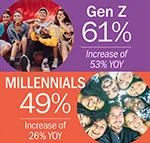 Rachel Kay Rachel Kay |
It’s been a doozy of a time for Consumer Packaged Goods challenger brands over the last few years. If the pandemic didn’t disrupt consumer shopping behaviors enough to shake up your retail strategy, supply chain woes and pricing wars may have thrown a wrench into growth plans. Or maybe it was the significant reduction in funding by VCs and the investment community. Or maybe it was just sheer competition in crowded categories. We’ve seen an influx of fantastic brands shutter doors as the industry faces insurmountable headwinds, and it’s going to be a slow build before we start seeing a sense of normalcy.
The good news is that overall interest in better-for-you and niche CPG brands continues to build as consumer interest in food as medicine, health-boosting whole foods and brands that support planetary health isn’t going anywhere. It’s not just tough-as-nails emerging brands leading the way. The biggest food manufacturers in the world are investing heavily in healthier options as a growing part of their brand portfolios. Kraft Heinz modernized its iconic portfolio with plant-based options last year. PepsiCo Frito Lay has acquired several better-for-you snack brands over the past several years. Mondelez’s SnackVentures seeks to support early-stage CPG brands. Many former start-ups have been acquired by big names: Alexia Foods by ConAgra, Annie’s Homegrown by General Mills, Earthbound Farm by WhiteWave, Justin’s Nut Butter by Hormel, Kashi by Kellogg Company. The list goes on.
So, what’s the secret ingredient to a long and prosperous shelf life? Below are some tips to help you thrive as a challenger brand.
Articulating your point of difference
We often speak with brands who claim to be creating a new category, but let’s be real, that’s rarely the case. Proof of concept is what breeds innovation, so the real opportunity is to one-up the competition with a fresh point of view. What do you bring that’s new and better? Is it a nutritional benefit? Is it a modern spin on an old favorite? Clearly articulate your differentiators and repeat consistently—on packaging, through marketing, and on your social profiles and website. Bare Snacks, a former client of ours, is a great example. It entered the snackable produce space, which was full of decent choices mixed in with a healthy dose of fried poofs, pillows and other Frankenfoods boasting little more than an obliterated carrot in every serving. Bare helped establish snackable produce as a real snacking category, claiming real estate on store shelves. We aggressively focused on the cooking methods and the clean, minimal ingredients to win over consumers through nutrition and help secure an acquisition from PepsiCo’s Frito-Lay.
| This article is featured in O'Dwyer's Mar. '24 Food & Beverage PR Magazine (view PDF version) |
Another brand that brings this thinking to life for me is The Good Crisp Company. Starting with a riff on Pringles and innovating with a twist on other snacking favorites, the brand is successfully building off iconic favorites by adding heightened nutritional benefits to modernize a successful concept. From my perspective, it’s working!
Too broad, or too vague
We often see two types of clients: those who want to appeal to a mainstream audience and those who target a niche so refined it alienates consumers who might be open to trying new products. We recommend defining a target audience that’s both clearly articulated but also inclusive. In other words, somewhere in between.
A great example is the Keto trend that became hot several years ago. A number of brands hoping to capture this passionate audience included the word Keto in their names and branding. A great move if you want to attract a Keto-only audience, but not realistic for longevity when we know that dietary trends tend to peak and fizzle out over time. Consumers seeking to discover lower sugar options but aren’t interested in following a restrictive keto diet may take a hard pass at such distinct branding. We’re seeing those brands now pivoting to more inclusive language—lower sugar, higher protein—to capture a wider audience.
That said, we also take pause when a brand positions itself as a solution for everyone, because it makes it challenging to develop messaging that isolates a key point of difference. Figure out who you want to attract and develop core messaging that engages and drives trial by saying “we made this with you in mind!”
One and done, or a slow drip
An interesting trend we’ve seen when talking to prospective clients this year is a pivot from long-term growth marketing to short-term stunts and spurts to drive growth. This stems from a desire to ensure efficient spending, which sounds great but can lack strategy, particularly for emerging brands. While ROI and maximizing returns are important, campaigns and stunts can be short-sighted as they are here and gone in a flash and you miss the opportunity for ongoing, day-in and day-out awareness and brand building. Stunts and large campaign partnerships are also incredibly expensive and should be activated at a certain point in a brand’s lifecycle. Being weary of investing all your eggs in one basket early on hoping for a silver bullet. There’s no silver bullet.
Case in point: Solo Stove’s campaign with Snoop Dog. What brand again? The campaign got a lot of fun publicity for Snoop but didn’t do a thing for sales of the firepit. And now, it’s over with a thud.
When it comes to your marketing and PR strategies, we recommend you think like a money manager. Good money managers talk about long-game strategies with conservative portfolios and investment in tried-and-true players to create wealth, so when you retire you can spend your remaining years on the golf course or cruising the high sea. They don’t recommend trying to hand-pick a hot stock in the hopes of winning big. The same is true with marketing. It’s critical to create household recognition for your brand with a consistent and sustained strategy rather than trying to garner consumer interest with a one-and-done news stunt that is designed to get people talking, but not necessarily buying. You’ll get a better bang for your buck if you ignite an integrated marketing strategy designed to drive exposure online via product coverage, larger storytelling around your brand, influencer endorsement, shopper marketing and a robust social strategy.
Embrace, don’t alienate
Always lead with a positive message with your marketing, even if you’re solving for a negative issue. Food, at its core, is about keeping us alive. But it’s so much more! It’s a social occasion. It drives culinary exploration. It goes great with Netflix. It breaks up a busy workday. It creates euphoria. So, the last thing your marketing strategy should do is shame your target consumer. It should empower. Telling consumers that they’re taking jobs away from farmers if they don’t brew this fair-trade coffee isn’t going to scare people into switching brands. Food is a joyful experience, so make your message one that gets consumers excited and inspired. And plain and simple, focus on the experience of the food or beverage—because at the end of the day, that’s what your consumer wants.
The sober-curious movement has done a fantastic job of attracting Gen Zers with this strategy. Rather than gain acceptance by scaring people, supporters have made the effort inclusive via varying levels of participation rather than an all-or-nothing approach. They celebrate stories of how much better life can be by going alcohol-free, or simply just drinking less. It’s an aspirational message that anyone can get on board with.
Make marketing pay nice
Every component of your business strategy—from sales to public relations, to social media, to marketing—needs to play together cohesively in the same sandbox. Often, these tactics are disconnected from each other, leading to a fractured effort. For example, PR is interested in driving big media hits while your social team wants to see lots of engagement. Building programs that align with each of these initiatives can amplify a program’s success. Stanley’s recent wins are a perfect example: Rabid fans wear the water bottle as a badge of honor on social media, while an aggressive PR strategy leverages the craze in traditional media and an aggressive paid marketing campaign ensures consumers don’t get lost on the hunt for their favorite hydration vessel. Finally, collaborations with like-minded brands create new news and a new reason to Buy. Just. One. More.
Don’t lead with impact, follow with impact
Many brands seek to differentiate by elevating their sustainability and impact initiatives, which is fantastic in a world where consumers want to create impact through their purchasing decisions. But when you’re talking about food and beverage, that message needs to be secondary to taste and experience. Most consumers won’t substitute their favorite products for a lesser alternative because it boasts an environmental impact. Brands need to validate a consumer’s decision to eat delicious food with a support message of the impact that decision has on planetary wellness.
The future is ripe for disruption and the CPG industry plays a key societal role. After all, everyone needs to eat to survive. Our job is to make sure we eat to thrive!
***
Rachel Kay is Managing Partner at FINN Partners.


 What the biggest meal of the day can teach us about serving up effective nutrition communications campaigns.
What the biggest meal of the day can teach us about serving up effective nutrition communications campaigns. Strategic communications strategies for success in the growing “food is medicine” movement.
Strategic communications strategies for success in the growing “food is medicine” movement. How brands can authentically communicate sustainability issues and create a brand experience that’s compatible with consumers’ values.
How brands can authentically communicate sustainability issues and create a brand experience that’s compatible with consumers’ values. Communicating the effects that climate change and a growing world population have on our food system—and why change is needed.
Communicating the effects that climate change and a growing world population have on our food system—and why change is needed. More younger Americans are abstaining from alcohol, according to recent research on the growing sober-curious movement, presenting a challenge—and an opportunity—for beverage marketers in 2024.
More younger Americans are abstaining from alcohol, according to recent research on the growing sober-curious movement, presenting a challenge—and an opportunity—for beverage marketers in 2024.


 Have a comment? Send it to
Have a comment? Send it to 
No comments have been submitted for this story yet.